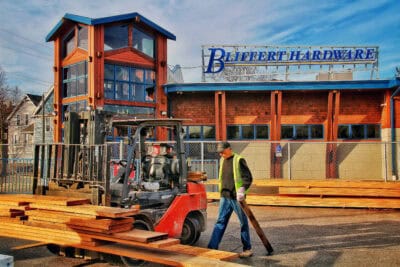BY JOHN FORBES
MANUFACTURER SERVICES DIRECTOR
NATIONAL WOOD FLOORING ASSOCIATION
CHESTERFIELD, MO
800-422-4556
WWW.NWFA.ORG
Wood floors have been a part of human culture for centuries. This is evidenced by the numerous examples of wood floors that are 300-plus years old, and still in use today, throughout Europe. In the United States, wood floors have been a part of American households since the birth of our nation, but their use and popularity has evolved over time.
Prior to the 1900s, wood floors were used almost exclusively in the homes of royals and upper middle class society. One of the reasons for this is that they involved intense labor by expert craftsmen that most people could not afford. The 1875 painting by Gustave Caillebotte called “The Floor Scrapers” shows what this process was like at the time. In fact, it was quite common that one floor could take years to complete.
Around the turn of the century, several technological advances occurred that simplified this process considerably. First, in 1885, side matchers were invented, which led to the development of tongue and groove, which is still used in wood flooring today. A few years later, in 1898, end matchers were introduced as well. Prior to these two innovations, wood flooring had to be fastened directly to floor joists. Subfloors were not common at this time, so these two innovations were major steps forward in the installation process.
With the advent of World War II, wood flooring once again experienced a surge in popularity. Factory finished floors became more prominent at the time. This occurred because the Office of Price Administration created fixed prices on products produced during the war so that no individual or company could profiteer from the conflict. Factory finished wood floors were considered a different product from unfinished wood flooring, so installers were able to get a better price. The resulting housing boom for shipyard and factory workers also increased the demand for wood floors as well.
Today, the wood flooring market has diversified tremendously, and consumers have more choices than ever before. Wood floors cannot only be installed on wood subfloors, but also on concrete slabs, making them a great choice for basements, or multifamily homes like apartments or condos. They also can be floated above existing floor coverings in some cases, which makes them extremely versatile.
Wood floors also have a number of advantages over other flooring product types.
Wood floors offer timeless value. They can last for hundreds of years when they are properly maintained, which provides significant long-term value. Wood floors also will adapt to many changes in décor over the years, without looking outdated. Wood floors can be refinished numerous times during their services lives, which is not possible with other flooring options. Finally, wood floors have less lifetime cost than other flooring options, because they simply don’t need to be replaced as often.
Wood floors are hypoallergenic, which is a huge advantage for allergy sufferers. They don’t harbor microorganisms or pesticides tracked in from outdoors like other flooring options can. Wood floors minimize the accumulation of dust, mold, and animal dander, and the EPA states that Hardwood floors improve indoor air quality.
Wood floors are easy to maintain. Routine maintenance requires nothing more than sweeping or dust mopping the floors to remove surface dust and debris. If the floors have bevels, vacuuming the floors with the beater bar turned off to remove dust from between the floorboards is all that is required. Using a professional cleaning product as needed to remove dirt and grime is easy and convenient, and if the floors have begun to look dull, a professional can recoat the floor to restore luster.
Finally, wood floors increase the value of the home or building. Surveys reveal that 80 percent of consumers would choose wood floors in their dream homes. In addition, real estate agents concluded that homes with wood floors sell faster and for more money than homes without wood floors, making them a great long-term value.
The National Wood Flooring Association has detailed information about the history and benefits of wood flooring available through NWFA University, an online training platform that is convenient and affordable. More information is available at nwfa.org/nwfa-university.aspx.









